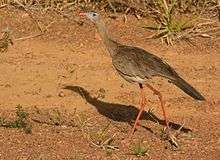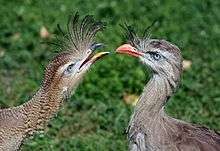Red-legged seriema
The red-legged seriema (Cariama cristata), also known as the crested cariama, and crested seriema, is a mostly predatory terrestrial bird in the seriema family (Cariamidae), included in the Gruiformes in the old paraphyletic circumscription, but increasingly placed in a distinct order Cariamiformes (along with three extinct families). The red-legged seriema inhabits grasslands from Brazil south of the Amazon to Uruguay and northern Argentina. It is estimated that its range covers an area of 5.9 million km2, although it is not found everywhere in this region. The species is absent from the Mata Atlântica and planalto uplands along the coast of Brazil.[1] Like the black-legged seriema, farmers often use them as guard animals to protect poultry from predators and sometimes human intruders.[2]
| Red-legged seriema | |
|---|---|
 | |
| Near Goiânia in central Brazil | |
| Scientific classification | |
| Kingdom: | Animalia |
| Phylum: | Chordata |
| Class: | Aves |
| Order: | Cariamiformes |
| Family: | Cariamidae |
| Genus: | Cariama Brisson, 1760 |
| Species: | C. cristata |
| Binomial name | |
| Cariama cristata (Linnaeus, 1766) | |
| Synonyms | |
|
(Genus)
(Species)
| |
Taxonomy
The red-legged seriema was described in 1766 by the Swedish naturalist Carl Linnaeus in the twelfth edition of his Systema Naturae. He coined the binomial name Palamedea cristata.[3] The red-legged seriema is now the only species placed in the genus Cariama that was introduced by the French zoologist Mathurin Jacques Brisson in 1760.[4][5] The specific epithet cristata is Latin for "crested", "plumed" or "tufted".[6] The German naturalist Georg Marcgrave used the Latin word Cariama for the red-legged seriema in his Historia naturalis Brasiliae which was published in 1648.[7] The name is derived from the Portuguese word çariama for the red-legged seriema which in turn comes from the Tupi language word sariêma for a crested bird.[8]
Description

It is 75 to 90 cm (30 to 36 in) long and weighs about 1.5 kg, with a fairly long neck, tail, and legs. The plumage is medium brown above with black markings; pale brown on the head, neck, and breast; and white on the belly. The tail has a black band near the tip and a white tip. The beak and legs are red, and the eyes are yellow. Soft feathers emerge from the base of the bill to form a fan-shaped crest.[9]
Many other characteristics are shared with the black-legged seriema (Chunga burmeisteri), the only other living member of its family. Some of these traits are discussed in the Cariamidae article.
The song has a quality described as "a cross between 'the serrated bark of a young dog and the clucking of turkeys'".[10] At the loudest part of the song, the bird has its neck bent so its head is touching its back. Both members of a pair as well as young down to the age of two weeks sing; often one member of a family starts a song just as another finishes, or two sing simultaneously. The song can be heard several kilometres away; in Emas National Park, Brazil, in 1981–1982, observers often heard four red-legged seriemas or groups singing at once.[11]
The full song consists of three sections:
- Repeated single notes at constant pitch (1,200 to 1,300 Hz) and duration but increasing tempo
- Repeated two- or three-note subphrases of slightly higher pitch with increasing tempo
- Subphrases of up to 10 notes, shorter ones rising in pitch and longer ones falling, two-subphrase combinations increasing in number of notes and tempo and then decreasing in tempo.
Their song was notably sampled by Boards of Canada on their track "Happy Cycling" on their debut album Music Has the Right to Children, which was taken from the Vangelis album La Fête Sauvage.
Ecology
The red-legged seriema prefers grassland habitat to any other. Though it likes to inhabit lush meadows near rivers, it will not readily move into wetlands or crop fields.[12] It is usually seen singly or in pairs, but sometimes in groups up to four, apparently families. It typically walks on the ground and can easily run faster than a human in its habitat. It will flee a car on foot at speeds up to 25 km/h (15 mph) before flying.[11]
In one conflict between two birds, they jumped at each other feet-first, keeping their balance by flapping.[11]
This species nests on the ground[9] or in a bush or tree up to three m above the ground. In the latter case adults jump into the nest rather than fly.[11]
Gallery
.jpg) The sickle claw of a red-legged seriema, used in fighting
The sickle claw of a red-legged seriema, used in fighting Jacksonville Zoo, Florida
Jacksonville Zoo, Florida Jacksonville Zoo, Florida
Jacksonville Zoo, Florida_-_Weltvogelpark_Walsrode_2013-02.jpg) Weltvogelpark Walsrode, Germany
Weltvogelpark Walsrode, Germany_-_Weltvogelpark_Walsrode_2013-03.jpg) Front view of the head
Front view of the head-1.jpg) Screaming Cariama cristata at Parque das Aves (Foz do Iguaçu)
Screaming Cariama cristata at Parque das Aves (Foz do Iguaçu)
References
- BirdLife International (2016). "Cariama cristata". IUCN Red List of Threatened Species. 2016: e.T22692205A93341300. doi:10.2305/IUCN.UK.2016-3.RLTS.T22692205A93341300.en.CS1 maint: uses authors parameter (link)
- https://www.blairdrummond.com/animals/red-legged-seriema
- Linnaeus, Carl (1766). Systema naturae : per regna tria natura, secundum classes, ordines, genera, species, cum characteribus, differentiis, synonymis, locis (in Latin). Volume 1, Part 1 (12th ed.). Holmiae (Stockholm): Laurentii Salvii. p. 232.
- Brisson, Mathurin Jacques (1760). Ornithologie, ou, Méthode Contenant la Division des Oiseaux en Ordres, Sections, Genres, Especes & leurs Variétés (in French and Latin). Paris: Jean-Baptiste Bauche. Vol. 1, p. 48, Vol. 5, p. 516.
- Gill, Frank; Donsker, David, eds. (2019). "Bustards, mesites, seriemas, Kagu, flufftails, finfoots". World Bird List Version 9.1. International Ornithologists' Union. Retrieved 9 April 2019.
- Jobling, J.A. (2019). del Hoyo, J.; Elliott, A.; Sargatal, J.; Christie, D.A.; de Juana, E. (eds.). "Key to Scientific Names in Ornithology". Handbook of the Birds of the World Alive. Lynx Edicions. Retrieved 9 April 2019.
- Marcgrave, Georg (1648). Historia naturalis Brasiliae (in Latin). Liber Quintus: Qui agit de Avibus. Lugdun and Batavorum (London and Leiden): Franciscum Hackium and Elzevirium. p. 203.
- Jobling, J.A. (2019). del Hoyo, J.; Elliott, A.; Sargatal, J.; Christie, D.A.; de Juana, E. (eds.). "Key to Scientific Names in Ornithology". Handbook of the Birds of the World Alive. Lynx Edicions. Retrieved 9 April 2019.
- Holyoak, David T. & Heinsohn, Robert (2003): Seriemas. In: Perrins, Christopher (ed.): Firefly Encyclopedia of Birds: 222. Firefly Books. ISBN 1-55297-777-3
- H. Burmeister, quoted and translated by Redford & Peters (1986)
- Redford, Kent H. & Peters, Gustav (1986). "Notes on the biology and song of the Red-legged Seriema (Cariama cristata)" (PDF). Journal of Field Ornithology. 57 (4): 261–269.
- Accordi, Iury Almeida & Barcellos, André (2006): Composição da avifauna em oito áreas úmidas da Bacia Hidrográfica do Lago Guaíba, Rio Grande do Sul [Bird composition and conservation in eight wetlands of the hidrographic basin of Guaíba lake, State of Rio Grande do Sul, Brazil]. Revista Brasileira de Ornitologia 14(2): 101–115 [Portuguese with English abstract]. PDF fulltext Archived 2008-12-19 at the Wayback Machine
External links
| Wikimedia Commons has media related to Cariama cristata. |
| Wikispecies has information related to Cariama cristata |
| Wikisource has the text of the 1911 Encyclopædia Britannica article Seriema. |
- Red-legged seriema videos on the Internet Bird Collection
- Stamps (for Uruguay) with RangeMap
- Red-legged Seriema photo gallery
- Photo-High Res; Article geometer–"Brazil Birds"
